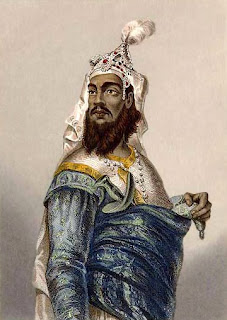Not much is known about the events in North India after the downfall of the Kushana dynasty but it seems probable that by the 3nd century AD the Indian territories east of the Punjab and Malwa were ruled by small Indian kings.
Chandra Gupta I
In this backdrop, in 320 AD there emerged a king named Chandra Gupta whose successors were instrumental in restoring the glory of the Mauryan dynasty (322 BCE - 185 BCE) to a great degree. He was the son of 2nd Gupta king Ghatotkacha whose father Srigupta I is considered the founder of the Gupta kingdom. It was, however, Chandra Gupta who was responsible for elevating the kingdom to the imperial status.
Chandra Gupta I strengthened his position by matrimonial alliance with the tribe of Lichchhavi whose princess Kumaradevi was married to him. (The Licchhavi clan made its reappearance, eight centuries after their defeat by Magadhan emperor Ajatashatru.)
Special coins were issued to commemorate this marriage which has been described by eminent historian and numismatist A S Altekar as the 'most dominating political event of the reign of Chandragupta I '.
Chandragupta I was the first Gupta ruler who assumed the title of Maharajadhiraja, "supreme King of great Kings".
Samudra Gupta
Samudra Gupta (reigned c.330 – c.380) was appointed by his father Chandra Gupta I to succeed him. However, the coins of an obscure prince, Kacha, suggest that his accession to the throne did not go unchallenged.
A skillful military leader and administrator as well as a patron of learning, Samudragupta is called Indian Napoleon by the British historian V.A. Smith. A detailed record of Samudragupta’s reign is contained in the Allahabad pillar inscription composed by his court poet and minister Harisena.
Chandragupta II
Chandragupta II succeeded to the Gupta throne after his father Samudra Gupta. According to one school of thought, before Chandragupta II his elder brother Ram Gupta ruled the Gupta empire and had to give way to his younger brother who saved the empire from a great calamity in the form of a Saka invasion.
Ancient India culture reached its climax during the reign of Chandragupta II. Kalidasa, the greatest of India’s poets and dramatists, and the famed astronomer Varahamihira were patronized by him. Chinese traveller Faxian (Fa-hsien) who came to India during his rule to collect authentic copies of the Buddhist scriptures attest the prosperity and happiness of the Gupta empire.
Chandra Gupta II is generally identified with a king called Chandra to whom is dedicated the Iron Pillar of Meharauli in Delhi.
Kumara Gupta I
Chandragupta II was succeeded by his son Kumara Gupta I (c. 415-455 AD), who like his grandfather Samudragupta, performed the Vedic horse sacrifice (Ashvamedha). He managed to keep the vast Gupta dominions intact.
In his last years, the Gupta empire suffered a severe blow in the form of attack by the Hunas, the barbaric tribes from Central Asia. Kumara Gupta I died during the war with the Hunas who were finally defeated by his son Skanda Gupta.
Skandagupta
Skandagupta, who ruled between 455 and 467 CE, was the last powerful ruler of the Gupta Empire. He ascended the throne after the death of his father Kumar Gupta I.
Skanda Gupta succeeded in keeping the Hunas at bay by defeating them. To mark the occasion he justifiably assumed the title of Vikramaditya.
After his death in 467 AD, Skanda Gupta was succeeded by half-brother Purugupta.
Vishnugupta was the last ruler of the Gupta empire.
Bibliography
A. S. Altekar: The coinage of the Gupta empire
A. L. Basham: The Wonder that was India







